The “Achieving Circularity” study highlights the fact that no silver bullet solution can create a zero-waste circular plastic economy in Norway, but rather a combination of interventions across the full plastics value chain. It also shows that, while all 10 system interventions under the System Change Scenario are important, reducing avoidable plastic consumption and scaling sorting capacity are the backbone of any circular plastic economy strategy. Similarly, our analysis confirms that recycling alone – no matter how ambitiously it is implemented – will not achieve Norway’s economic, environmental and social goals given the objective technical limitations of this technology and the fact that many materials are not technically or economically recyclable.
Conclusion
Our central message is that combining upstream interventions, such as reduction and design for recycling, with downstream interventions, such as enhancing sorting and recycling, is critical for success. A better plastic system in Norway relies on both more responsible plastic consumption and more responsible plastic waste management.
All stakeholders have a role to play. Achieving the ambitious changes envisioned under the System Change Scenario requires the government to incentivise more sustainable business models based on the reuse of materials and realign incentives that currently give virgin plastic feedstock an advantage over recycled secondary materials. They also need to enact ambitious policy measures across the plastics value chain to foster innovation.
"combining upstream interventions (ie reduction and design for recycling), with downstream interventions (ie enhancing sorting and recycling) is critical for success"
Industry needs to remove avoidable, single-use and hard-to-recycle plastic from the market, invest in material and business model innovation, and join with governments to help finance improved waste collection and sorting.
Public private collaborations are required to set standards on materials, formats, reuse, and recyclability. And the effective management of every step of this progress is essential.
While this study presents a diverse set of pathways representing different potential strategies for Norway’s plastic system, we recognise that there are dozens of possible levers and system variables across this highly complex system.
We therefore invite all stakeholders to test the open-access, dynamic scenario analysis tool that we developed in order to bring our model and wealth of data to your fingertips. Please try our Plastsimulator.
The goal of this study is to accelerate the transition to a zero-waste circular plastic economy in Norway by providing a first-of-its-kind, full-system model of the Norwegian plastic system that helps guide policymakers, industry executives, investors, and civil society representatives through the highly complex plastic landscape as they advance in their quest to achieve circularity in Norway.
Our hope is to help strengthen the dialogue between industry and the public sector, and ground it on scientific evidence and analytical rigour.
Plastsimulator
Complementing this study is an open access, online simulator tool ‘Plastsimulator’ that enables stakeholders to create and test their own science-based scenarios and understand the economic, environmental and social impacts of different pathways, try now.
Contact
We would be happy to discuss or present the insights from the ‘Achieving Circularity’ studies in more detail. Please contact the team at [email protected]
Glossary
There is a glossary of terms used in this study available here >
Further Reading
This study is part of the Breaking the Plastic Wave series
Bibliography
- All references to plastic in this report refer to household and industry packaging waste and household plastic waste.
- Data from Green Dot Norway
- Regulations 1.9.2017 and 1.1.2018
- Mepex estimate analysis based on Green Dot Norway data
- Mepex analysis based on Green Dot Norway data
- Mepex Analysis
- Plastic utility is defined in this report as the total consumer benefit from consuming a good or a service provided by plastic products in a business-as-usual scenario, measured in tonnes of plastic
- Nordic Ministerial Declaration adopted in October 2020.
- https://ec.europa.eu/environment/topics/waste-and-recycling/packaging-waste_en
- An understanding that technological limitations will prevent recycling from nearing 100%
- DIRECTIVE 2008/98/EC of the European Parliament on waste
- Vi må gjenvinne mer plast. Slik skal vi få det til. – HMF (handelensmiljofond.no), 2021
- Primary microplastics are defined as microplastic particles which enter the environment in that state, as opposed to secondary microplastics, which arise from the fragmentation of macroplastic leakage.
- Scenario 4 and 5 only differ in the collection system. In scenario 4, plastic waste is collected as mixed waste with other residuals while in scenario 5 the current collection system is assumed with moderate improvements in the source separation of plastic
- Statistics Norway Population – SSB (https://www.ssb.no/en/befolkning/nokkeltall/population)
- Material Economics, the Circular Economy Report (PG. 78) (https://materialeconomics.com/publications/the-circular-economy)
- Skyfilling is defined as the action of releasing GHGs from waste into the atmosphere as opposed to landfilling.
- Miljødirektoratet: https://www.miljodirektoratet.no/tjenester/klimatiltak/karbonbudsjettet/
- Adjusted for Norway energy mix.
- https://ec.europa.eu/environment/green-growth/waste-prevention-and-management/index_en.htm
- National Research Council (US) Committee on Health Effects of Waste Incineration. Washington (DC): National Academies Press (US); 2000.
- Air Quality Consultants, Health Effects due to Emissions from Energy from Waste plant in London (May 2020)
- Parkes, Brandon, et al. “Risk of congenital anomalies near municipal waste incinerators in England and Scotland: Retrospective population-based cohort study.” Environment international 134 (2020): 104845.
- Nzihou, Ange, et al. “Dioxin emissions from municipal solid waste incinerators (MSWIs) in France.” Waste management 32.12 (2012): 2273-2277.
- Setoodeh Jahromy, Saman, et al. “Fly ash from municipal solid waste incineration as a potential thermochemical energy storage material.” Energy & Fuels 33.7 (2019): 5810-5819.
- All exports data is from a Mepex Analysis based Norwegian Environmental Agency and Green Dot Norway sources from export declarations; the fate of those exports is based on an analysis by SYSTEMIQ.
- Reminder: the circularity index is defined as the sum of plastic utility reduced, substituted and recycled, divided by the total plastic utility
- Report of the High-Level Commission on Carbon Prices, 2017.
- Ppresent value of net costs incurred between 2021 and 2040 (capex and opex) incurred by all waste generated in Norway (including revenue streams) and covers the entire plastic value chain (i.e., plastic production, packaging conversion, collection, sorting, recycling and disposal including export cost, as well as the same cost for substitute materials, and estimated cost for the new business models).
- Ellen MacArthur Foundation, The New Plastics Economy, Catalysing Action, 2017 (Page 39)
- Vi må gjenvinne mer plast. Slik skal vi få det til. – HMF (handelensmiljofond.no), 2021.
- The Norwegian Environment Agency, Bio-based and Biodegradable Plastics (2018)
- Estimated amount by Mepex expert team.







